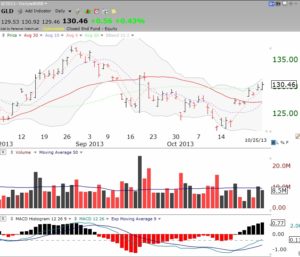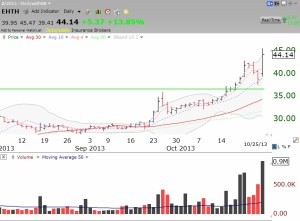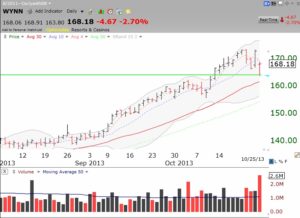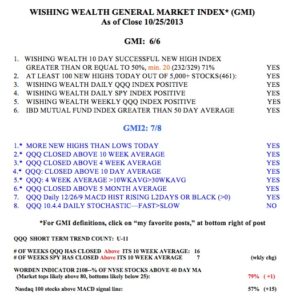The market remains in short and longer term up-trends. I hold a position in TQQQ , protected by put options. This should be an interesting week with earnings expected from AAPL and FB. I think GLD (ETF for gold) looks like it may be turning up. Check out this daily chart. Among the positives are that GLD is now back above its 30 day average (red solid line), the past 7 days have had large volume up days, and the MACD histogram has turned positive (black bars) the past 6 days. I own call options on GLD. Click on chart to enlarge.
I noticed that EHTH has been having some high volume advances after its recent green line break-out. Obamacare’s problems may be good for its bottom line. Check out this daily chart. T o find out more about green line charts, watch my free TC2000 December 2012 webinar. A link to the webinar appears to the right of my post.
On Friday, WYNN had a high volume retest of its green line break-out. Will it hold? Here is its daily chart.
Finally, here is the GMI table, which shows a lot of strength in my indicators. The GMI has been on a buy signal since the close on September 4. Since then, the QQQ has advanced +8.07%, the QLD +17% and the TQQQ +25.92%. In contrast, the SPY has advanced only +6.15% and the DIA +4.2%. Riding a leveraged index ETF during a sustained up-trend has proven very profitable to me. Of course, my put options protect my position and let me sleep at night. Check out the performance of the GMI based strategy here.




As always, I’m grateful for the insights that you offer freely.
I know that you’ve discussed using put options to hedge your long positions before, but what would be of immense help is if you could offer some details. For example, in this current signal, if one were to be long 100 shares of TQQQ, specifically what put options would one purchase ( or have purchased when going long)?
Buying a put is like buying insurance. One has to decide on the cost and risk one wants to take. Currently, one could buy a Nov 16 102 put option on the TQQQ for about $3.80/share. That guarantees an exit for around 98.20 (102-3.80 paid), excluding commissions. If one’s cost was much lower, this insurance might be worth it, especially if one expected a decline. One could also then write a call option on the position to reduce the cost of the put (creating a collar) but it would limit the up-side. Also, if the market strengthens, one could subsequently sell the put and reduce the cost of the insurance.